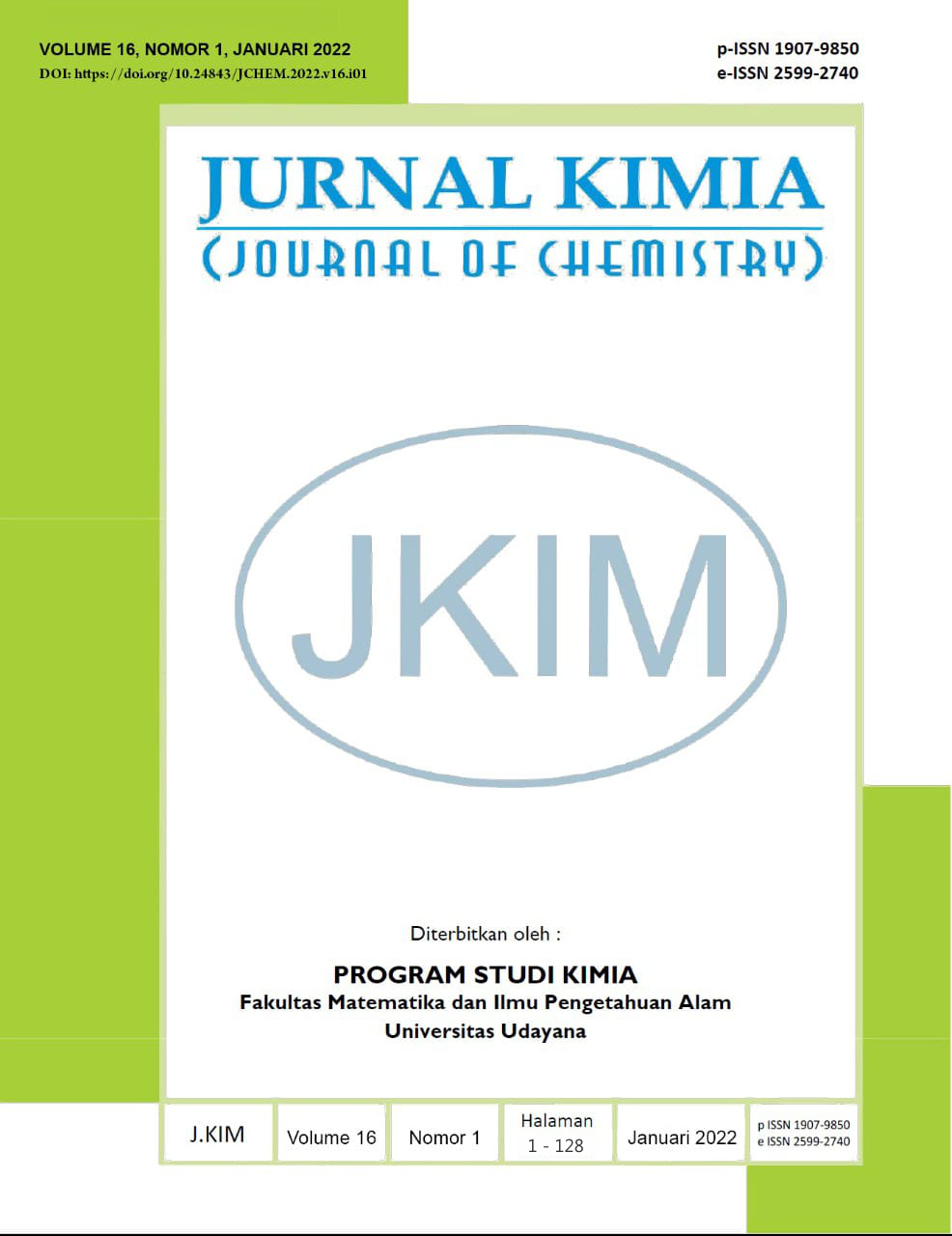PENGGUNAAN MOLEKUL CETAKAN ATENOLOL DAN MONOMER AKRILAMID PADA SINTESIS MOLECULAR IMPRINTING POLYMER
Abstract
Dalam beberapa kompetisi cabang olahraga, obat golongan antihipertensi seperti atenolol sering disalahgunakan penggunaannya oleh atlet yang membutuhkan ketenangan dan konsentrasi penuh sebagai doping. Saat ini teknik pemisahan yang banyak dilakukan untuk identifikasi atenolol salah satunya menggunakan sorben Molecular Imprinted Polymer (MIP). Tujuan dari penelitian ini adalah untuk mensisntesis MIP menggunakan molekul cetakan atenolol dan monomer akrilamid. Pelepasan molekul cetakan dilakukan dengan metode ekstraksi menggunakan pelarut methanol. Identifikasi kadarnya diukur menggunakan High Performance Liquid Chromatography (HPLC) dan dilakukan sampai dengan konsentrasi yang terukur di bawah nilai LOD. Hasilnya menunjukkan bahwa kadar atenolol hasil pelepasan kembali sebesar 8,88 ppm. Sementara nilai LOD dan LOQ yang dihasilkan masing-masing sebesar 11,184 ppm dan 37,282 ppm. MIP dikarakterisasi menggunakan Fourier Transform Infrared (FTIR) dan spektrum NIP (Non Imprinted Polymer) dan MIP yang dihasilkan memiliki pola yang sama dan diidentifikasi pada daerah bilangan gelombang 1500-500cm1. Kekuatan desorpsi antara MIP dan NIP telah diidentifikasi dan diperoleh data bahwa nilai AUC MIP lebih besar daripada nilai AUC NIP dengan nilai % terelusi sebesar 733,74%. MIP tersebut diaplikasikan pada tablet atenolol yang beredar di pasaran menggunakan eluen klorofom dan nilai perolehan kembali sebesar 53,33%.
Kata kunci: atenolol, doping, FTIR, HPLC, Molecular Imprinted Polymer (MIP).
Antihypertensive drugs like atenolol are frequently used as doping in many sports competitions by athletes who require calmness and full of concentration. Molecular Imprinted Polymer (MIP) sorbent is currently the most widely used separation technique for atenolol identification because of its high selectivity for atenolol adsorption. The aim of this research was to synthesize MIP using atenolol molecules and acrylamide monomer. The extraction using methanol was applied to release the imprinted molecules. The concentration of etenolol was measured by High Performance Liquid Chromatography (HPLC) that was carried out until the atenolol concentration was below the detection limit (LOD). The results showed that the concentration of atenolol released was 8.88 ppm. Meanwhile, the LOD and LOQ values ??were 11,184 ppm and 37.282 ppm, respectively. The Fourier Transform Infrared (FTIR) was used to characterize the MIP. The FTIR spectrum of NIP (Non Imprinted Polymer) and MIP showed the same pattern at the wave number range of 1500-500cm-1. The strength of desorption of MIP and NIP was determined, and data was gathered showing that the AUC MIP value was bigger than the AUC NIP one, with a percentage eluted value of 733.74 %. The MIP was applied to the commercially available atenolol tablets using chloroform eluent resulted in a recovery value of 53.33 %.
Keywords: atenolol, doping, FTIR, HPLC, Molecular Imprinted Polymer (MIP).
Downloads
References
Chen, W., Ma, Y ., Pan, J., Meng, Z ., Pan, G., Sellergren, B.. 2015. Molecularly Imprinted Polymers with Stimuli-Responsive Affinity: Progress and Perspectives. Polymers. 7:1689-1715
Coates, John. 2002. Interpretation of Infrared Spectra, A Practical Approach. Newtown USA: Coates Consulting.
Dachrianus. 2004. Analisis Struktur Senyawa Organik Secara Spektroskopi. Padang: Lembaga Pengembangan Teknologi Informasi dan Komunikasi (LPTIK) Universitas Andalas Padang.
Dewi, A. K. A. I. 2015. Penyalahgunaan Zat Terlarang (Doping Dan Napza) sebagai Upaya Peningkatan Stamina dalam Olahraga. Jurnal Pendidikan Kesehatan Rekreasi. 1: 15–19.
Goryński, K., Kiedrowicz, A., and Bojko, B. 2016. Development of SPME-LC–MS method for screening of eight beta-blockers and bronchodilators in plasma and urine samples. J of Pharm. and Biomed. Anal. 127: 147–155.
Gotardo, M. A., Tognolli, J. O., Pezza, H. R., dan Pezza. L. 2008. Detection of Propanolol in Pharmaceutical Formulations by Diffuse Reflactance Spectroscopy. Spect. Acta. 69: 1103-1109.
Hasanah, A.N., Kartasasmita, R.E., Ibrahim, S. 2015. Synthesis and application of Glibenclamide Imprinted Polymer for solid phase extraction in serum samples using itaconic acid as functional monomer. J of Appl. Sci. 15:1288-1296.
Hasanah, A.N., Pratiwi, R., Utari, T.N.D. 2019 . Synthesis of Atenolol-Imprinted Polymers with methyl methacrylate as functional monomer in propanol using bulk and precipitation polymerization method. J. of Anal. Meth. in Chem. 7:1-7
Hasanah, A.N., Shendi, S., Mutakin, dan Driyanti, R. 2017. Evaluation Performance of Molecularly Imprinted Polymer Prepared by Two Different Polymerization Method for Atenolol Recognition in Human Plasma. Asian J of Chem. 29(11): 2429-2433.
Herdiawan, R. 2013. Upaya Pencegahan Penyalahgunaan doping Golongan Psikotropika di Kalangan Pemain Sepak Bola. Skirpsi. Fakultas Hukum. Universitas Brawijaya.
Yan, H., Row, K.H. 2006. Characteristic and synthetic approach of moleculary imprinted polymer. Int. J. Mol. Sci. 7: 155-178
Yilmaz, H., dan Basan, H. 2017. Spectrofluorimetric determination of atenolol from human urine using high affinity molecularly imprinted solid-phase extraction sorbent. Luminescence. 32:1391-1397.

This work is licensed under a Creative Commons Attribution 4.0 International License






